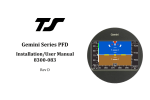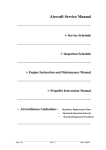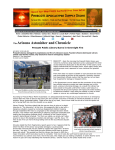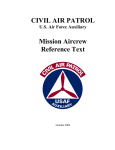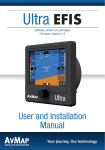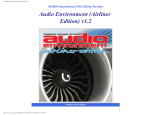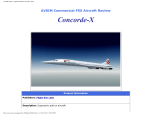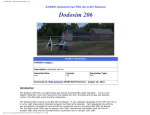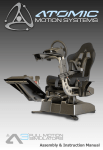Download INSTRUCTION MANUAL
Transcript
INSTRUCTION MANUAL Manufactured in the United States www.redbirdflightsimulations.com DISCLAIMER *With optional rudder pedals Information in this manual is subject to change without notice and does not represent a commitment on the part of the licensor. ©2013 Redbird Flight Simulations, Inc. All rights reserved. Trademarks used in this text: Redbird, Redbird Flight Simulations, Redbird TD and TD2, the Redbird TD and TD2 logo and the Redbird logo are trademarks of Redbird Flight Simulations, Inc., and are used by Redbird under license. Microsoft Flight Simulator, Microsoft Windows, Microsoft Game Studios are either trademarks or registered trademarks of Microsoft in the US and other countries. The software and hardware described in this document are provided under a license agreement. The software and hardware may be used or copied only in accordance with the terms of the license agreement. Other trademarks and trade names may be used in this document to refer to the entitles claiming the marks and names or their products. Redbird Flight Simulations, Inc. disclaims any proprietary interest in trademarks and trade names other than its own. April 2013 Rev. 5.0 AA APPROV ED BATD F The Redbird TD/TD2 are an FAA approved Basic Aircraft Training Device (BATD)* that represents a generic highwing, single-engine, piston aircraft. This manual contains information on how to setup, use and troubleshoot the Redbird TD/TD2. The reader of this manual is expected to know how to fly an aircraft or to be participating in a structured and approved flight training program. This manual is in no respect a tutorial in visual flight, instrument flight or navigation. Its only purpose is to introduce the Redbird TD/TD2 hardware and software to enable a pilot to use this training device. CONTENTS 4 5 7 8 CHAPTER 1- GETTING STARTED Getting to Know Your Redbird TD/TD2 Simulated Aircraft Performance Specifications (TD) Simulated Aircraft Performance Specifications (TD2) 10 CHAPTER 2 - SETTING UP YOUR REDBIRD TD/TD2 11 Preflight Checklist 18 Optional Setup and Equipment 20 24 29 35 36 37 CHAPTER 3 - USING YOUR REDBIRD TD/TD2 Starting a Flight on a TD Starting a Flight on a TD2 While in Flight Keyboard Functions for Glass Panel Keyboard Functions for Analog/Steam Panel 43 CHAPTER 4 - TIPS 44 Practicing Approaches 53 54 57 58 CHAPTER 5 - TROUBLESHOOTING Troubleshooting Tips Keeping Your Software Up-to-date Learning More, Service and Support 1 GETTING STARTED Your Redbird TD/TD2 is designed for easy setup and operation so that you can begin flying immediately. ! Retain all original packaging and shipping materials. ! Any unauthorized software on your Redbird TD/TD2 is prohibited and will void your warranty. GETTING STARTED Getting to Know Your Redbird TD/TD2 What’s in the boxes: Lower Instrument Panel Monitor Speakers Acrylic Adjustable Supporting Leg* (*Not needed if installed on optional Redbird TD Table) Thumbscrews Panel Thumbscrews Keyboard Computer 5 GETTING STARTED Redbird TD Specifications: ITEM SPECS Dimensions: 28.9” wide, x 24.25 deep, 49.12” tall TD Assembled Weight: 96.5 lbs Power: domestic-120 V, international-220V Dimensions: 28.5” wide, x 24.25” deep , x 10” tall Lower Instrument Panel Weight: 48-1/2 lbs Other: (4) thumbscrews, (1) USB cable Dimensions: 28” wide, x 6.81” deep, x 19” tall Upper Instrument Panel Adjustable Supporting Leg Weight: 37-1/2 lbs Other: (1) power cable, (1) video cable, (1) USB cable, (4) loose thumbscrews Dimensions: 19” (extends to 22”) Dimensions: 16” wide, x 17” tall x 7-1/4” deep Computer Weight: 10 1/2 lbs Other: (1) power cable System Details: 22 x right/left channel speaker - 1.5 Watt - wired Speakers Keyboard 6 Connector Type: 1 x headphones (mini-phone stereo 3.5 mm), 1 x DC power input, 1 x audio line-in with 1 USB cable Dimensions: 11.3” wide X 8.9” tall X 1.0” deep Other: Compact Touch-pad with USB cable GETTING STARTED TD - Simulated Aircraft Performance Specifications: (See next page for TD2) Speed Maximum Sea Level................................................................ 126 Knots Rate of Climb at Sea Level................................................................ 730 FPM Service Ceiling ............................................................................... 14,000 FT Takeoff Performance Ground Roll ............................................................................ 960 FT Total Distance Over 50 FT Obstacle ........................................ 1630 FT Landing Performance Ground Roll ............................................................................ 575 FT Total Distance Over 50 FT Obstacle ........................................ 1335 FT Stall Speed Flaps Up, Power Off ............................................................... 48 KIAS Flaps Down, Power Off ........................................................... 43 KIAS Fuel Capacity ................................................................................. 56 GAL Engine .......................................................................................... 180 HP Propeller: Fixed Pitch, Diameter .............................................. 76 IN Simulated Aircraft Limitations: SYMBOL SPEED KIAS VNE Never Exceed Speed 163 VNO Maximum Structural Cruising Speed 129 VA Maneuvering Speed 98 VFE Maximum Flap Extended Speed 110 VX Best Angle of Climb 63 VY Best Rate of Climb 75 7 GETTING STARTED TD2 - Simulated Aircraft Performance Specifications: High Performance Speed Maximum Sea Level ........................................ 126 Knots ........ 145 Knots Rate of Climb at Sea Level......................................... 730 FPM........... 924 FPM Service Ceiling ........................................................ 14,000 FT ......... 18,100 FT Takeoff Performance Ground Roll ..................................................... 960 FT .............. 795 FT Total Distance Over 50 FT Obstacle ................. 1630 FT ............ 1514 FT Landing Performance Ground Roll ..................................................... 575 FT .............. 590 FT Total Distance Over 50 FT Obstacle ................. 1335 FT ............ 1350 FT Stall Speed Flaps Up, Power Off ....................................... 48 KIAS ............ 54 KIAS Flaps Down, Power Off ................................... 43 KIAS ............ 49 KIAS Fuel Capacity ......................................................... 56 GAL ............. 92 GAL Engine .................................................................. 180 HP ............. 230 HP Propeller: Fixed Pitch, Diameter ......................76 IN ................. 79 IN Simulated Aircraft Limitations: SYMBOL SPEED 8 KIAS HIGH PERFORMANCE VNE Never Exceed Speed 163 175 VNO Maximum Structural Cruising Speed 129 140 VA Maneuvering Speed 98 110 VFE Maximum Flap Extended Speed 110 140 VX Best Angle of Climb 63 64 VY Best Rate of Climb 75 84 VLO Maximum Landing Gear Operating Speed - 180 VLE Maximum Landing Gear - 152 GETTING STARTED What’s on the back of your Redbird TD/TD2: Power Port Power Switch Voltage Switch USB Ports Ethernet Port Video Port Speaker Port Monitor Computer Acrylic Lower Instrument Panel 9 2 Setting Up Your Redbird TD/TD2 This chapter will guide you through the Redbird TD/TD2 setup. SETTING UP YOUR REDBIRD TD/TD2 Preflight Checklist USE THE FOLLOWING ITEMS TO SETUP YOUR REDBIRD TD/TD2 Lower Instrument Panel with (4) thumbscrews, (1) USB cable Adjustable Supporting Leg Upper Instrument Panel with (1) power cable, (1) video cable, (1) USB cable, (4) loose thumbscrews Computer with power cable Keyboard Speakers THINGS TO KNOW PRIOR TO INSTALLATION ! You will need a sturdy, solid table with a maximum tabletop thickness of 2.25” including rails and the underlying structure. There must be at least 29” between the legs. If you are not installing your TD/TD2 on the optional Redbird TD Table, you must install the adjustable supporting leg. No tools are required for installation. The assembly is performed by hand-tightening only. The use of tools may lead to damage. Lift all items from both sides using correct lifting techniques. Seek assistance when lifting larger items. Retain all original packaging and shipping materials. Any unauthorized software on your Redbird TD/TD2 is prohibited and will void your warranty. 11 SETTING UP YOUR REDBIRD TD/TD2 STEP 1: Position the Instrument Panels and Install the Adjustable Supporting Leg Lower Instrument Panel • Slide the Lower Instrument Panel onto the table. (See Fig. 1) • Hand-tighten the (4) thumbscrews to ensure secure clamping of the Lower Instrument Panel to tabletop. The panel should be firmly secured and fixed in place. Tighten only as much as is needed to prevent movement. Do not over-tighten as this may cause damage. Do Not Use Tools Hand Tighten Only Fig. 1 12 SETTING UP YOUR REDBIRD TD/TD2 Install the Adjustable Supporting Leg* • Position the Adjustable Supporting Leg under the threaded opening at the bottom right hand corner of the Lower Instrument Panel. (See Fig. 2) • Hand-tighten the leg so that it is fully secured to the Lower Instrument Panel. • To adjust the Adjustable Supporting Leg height, twist the lower portion of the leg until the foot pad has reached the floor. Hand-tighten the wing nut to secure the leg. (See Fig. 3) Fig. 2 Fig. 3 (*Not needed if installed on optional Redbird TD Table) 13 SETTING UP YOUR REDBIRD TD/TD2 Monitor • Position the Monitor on top of Lower Instrument Panel, so that the holes are aligned. (See Fig. 4) • Pass the (4) loose thumbscrews through the aligned holes to attach the Monitor and Lower Instrument Panels. • Hand-tighten the thumbscrews so that the Monitor is fully secured. (See Fig. 5) Fig. 4 Fig. 5 STEP 2: Position the Computer • Place the Computer behind the Monitor on the Lower Instrument Panel. (See Fig. 6) • Ensure the back of the Computer is positioned to the right of the Monitor for easy access to the Computer ports. Monitor Computer Acrylic Lower Instrument Panel 14 Fig. 6 SETTING UP YOUR REDBIRD TD/TD2 STEP 3: Place and Connect the Acrylic • Slide the Acrylic onto the four screws on the monitor frame. • Hand-tighten the thumbscrews so the Acrylic is fully secured. (See Fig. 7) • On the bottom left corner of the back of the monitor, plug the red USB cable into the USB port on the Acrylic. (See Fig. 8) Plug the other end into the USB port marked in red on the back of the computer. (See Fig. 9) Fig. 7 Fig.8 STEP 4: Connect the Lower Instrument Panel The Lower Instrument Panel USB cable connections will be located on the back of the Computer. Look for the four USB ports that are similar in shape. (See Fig. 9) • Plug the blue USB cable into the USB port marked in blue. Fig.9 15 SETTING UP YOUR REDBIRD TD/TD2 STEP 5: Connect the Keyboard and Speakers Keyboard The Keyboard connection is located on the back of the Computer. (See Fig. 8) • Plug the USB keyboard cable into the USB port marked in orange. Fig.8 Speakers The Speaker connections will be located on the back of the Computer. (See Fig. 9) • Plug the purple USB cable into the USB port marked in purple. Plug the green audio cable into the green audio port. Fig.9 16 SETTING UP YOUR REDBIRD TD/TD2 STEP 6: Connect the Video and Power Cables • Plug one Power Cable into the back of the monitor. (See Fig. 10) Plug the opposite end into a standard wall outlet. • Plug the white Video Cable into the white marked video port on the back of the computer. Plug the opposite end into the back of the monitor. (See Fig. 11) • Plug the other Power Cable into the green marked power port on the back of the computer. (See Fig. 12) Plug the opposite end of the green Power Cable into a standard wall outlet. (Volt Setting:115V) Fig.10 Left Side - Power Fig.11 Right Side - Video IMPORTANT - VOLTAGE SETTING: Default voltage is set at 115. To change the voltage to your local standard, slide the red button located near the power outlet so that it reads 230V. (See Fig. 11) Fig.11 17 SETTING UP YOUR REDBIRD TD/TD2 STEP 7: Optional Setup and Equipment Internet Setup To access the Internet for Redbird software updates and downloads: • Connect one end of an Ethernet cable (not included) to the Ethernet port on the back of your Redbird TD/TD2 Computer. • Connect the other end to your network outlet. Redbird will automatically notify you if there are any updates after you’ve powered on the TD/TD2. Ethernet Port 18 SETTING UP YOUR REDBIRD TD/TD2 Rudder Pedal Setup The Redbird TD/TD2 is compatible with Saitek Pro Flight Rudder Pedals and CH Pro Pedals. • Plug the USB pedals into an empty USB port located on the back of the Computer. Install the rudder pedals prior to powering on the Redbird TD/TD2. 19 3 Using Your Redbird TD/TD2 The Redbird TD/TD2 has many features which will help improve your flying skills. For example, you can fly anywhere in the world, day or night in a variety of weather conditions. USING YOUR REDBIRD TD/TD2 Start Up • On the back of the computer, ensure the power switch is turned on. (See Fig.12) Fig.12 • Push the power button located on the front of the Computer. (See Fig.13) Fig.13 21 USING YOUR REDBIRD TD/TD2 The Redbird TD/TD2 will start and the Begin Flight Menu will appear. (See Fig. 14) Begin Flight Menu Fig.14 22 USING YOUR REDBIRD TD/TD2 If you get a System Failed, Check Connections, refer to page 45 for troubleshooting. System Failed 23 USING YOUR REDBIRD TD STARTING A FLIGHT ON THE TD (See page 29 for TD2) With the Redbird TD you can specify where your flight begins and under what conditions. To begin a flight, select the following conditions: 1. AIRCRAFT LOCATION 2. TIME OF DAY 3. WEATHER CONDITIONS STEP 1: Set Aircraft Location You can choose to start your flight ON THE GROUND at an airport or IN THE AIR. 24 USING YOUR REDBIRD TD To start your flight ON THE GROUND: • Type in the ICAO designation for the airport. • Select the RUNWAY from the drop down box. To start your flight IN THE AIR: Enter the aircraft position in this order: 1. NM FROM - enter the distance from a desired airport NAVAID or intersection. 2. NAV IDENT - enter the airports ICAO identifier, NAVAID, or Intersection. The Redbird TD/TD2 will notify you if you’ve entered an invalid airport NAVAID or Intersection. Invalid NAVAID 3. BEARING - enter the bearing from the desired NAVAID 4. ALTITUDE - enter the altitude in feet MSL. If the chosen altitude is too low for the position specified, the aircraft will be placed at 1000 feet at the selected NAVAID. 5. HDG - enter the aircraft heading. 25 USING YOUR REDBIRD TD STEP 2: Set Time Select DAY or NIGHT. STEP 3: Set Weather Conditions Enter weather conditions. WIND Enter the desired wind direction, speed and gusts. VISIBILITY Use the drop down box to select the visibility on the ground. Visibility coverage ranges from 1/16 up to 10+ miles. 26 USING YOUR REDBIRD TD RAIN Select the desired rain intensity. You may choose from: NONE LIGHT MODERATE HEAVY CLOUD COVERAGE Select the cloud coverage. NONE FEW SCATTERED BROKEN OVERCAST Enter cloud base in feet MSL. 27 USING YOUR REDBIRD TD STEP 4 BEGIN FLIGHT: Once you are satisfied with your selections, click BEGIN FLIGHT. Congratulations you are now ready to fly. All flights begin in a paused state. To begin flying, press the F12 pause button on the keyboard. Other Options END A FLIGHT Press the ESC key on your keyboard to END FLIGHT ESC END FLIGHT SHUTDOWN THE REDBIRD TD/TD2 Click the SHUTDOWN button from the Begin Flight Menu to turn off your Redbird TD/TD2. 28 USING YOUR REDBIRD TD2 STARTING A FLIGHT ON THE REDBIRD TD2 (See page 24 for the TD) With the Redbird TD2 you can specify where your flight begins and under what conditions. To begin a flight, select the following conditions: 1. AIRCRAFT OPTIONS 2. AIRCRAFT LOCATION 3. TIME OF DAY 4. WEATHER CONDITIONS Begin Flight Menu STEP 1: Select Aircraft Options You can select/deselect all that apply: • Retractable Gear • Constant Speed Prop • High Performance If you choose not to select either of these options, the TD2 will simulate a 180 HP generic single engine aircraft. 29 USING YOUR REDBIRD TD2 STEP 2: Set Aircraft Location You can choose to start your flight On the Ground at an airport or In the Air. 30 USING YOUR REDBIRD TD2 To start your flight ON THE GROUND: • Type in the ICAO designation for the airport. • Select the RUNWAY from the drop down box. To start your flight IN THE AIR: Enter the aircraft position in this order: 1. NM FROM - enter the distance from a desired airport NAVAID or intersection. 2. NAV IDENT - enter the airports ICAO identifier, NAVAID, or Intersection. The Redbird TD/TD2 will notify you if you’ve entered an invalid airport NAVAID or Intersection. Invalid NAVAID 1. BEARING - enter the bearing from the desired NAVAID 2. ALTITUDE - enter the altitude in feet MSL. If the chosen altitude is too low for the position specified, the aircraft will be placed at 1000 feet at the selected NAVAID. 3. HDG - enter the aircraft heading. 31 USING YOUR REDBIRD TD2 STEP 3: Set Time Select DAY or NIGHT. STEP 4: Set Weather Conditions Enter weather conditions. WIND Enter the desired wind direction, speed and gusts. VISIBILITY Use the drop down box to select the visibility on the ground. Visibility coverage ranges from 1/16 up to 10+ miles. 32 USING YOUR REDBIRD TD2 RAIN Select the desired rain intensity. You may choose from: NONE LIGHT MODERATE HEAVY CLOUD COVERAGE Select the cloud coverage. NONE FEW SCATTERED BROKEN OVERCAST Enter cloud base in feet MSL. 33 USING YOUR REDBIRD TD2 STEP 4 BEGIN FLIGHT: Once you are satisfied with your selections, click BEGIN FLIGHT. Congratulations you are now ready to fly. All flights begin in a paused state. To begin flying, press the F12 pause button on the keyboard. Other Options END A FLIGHT Press the ESC key on your keyboard to END FLIGHT ESC END FLIGHT SHUTDOWN THE REDBIRD TD/TD2 Click the SHUTDOWN button from the Begin Flight Menu to turn off your Redbird TD/TD2. 34 USING YOUR REDBIRD TD/TD2 WHILE IN FLIGHT KEYBOARD FUNCTIONS The function keys on the keyboard allow you to end a flight, enable/disable aircraft failures, show/hide gauges, pause/resume flight, clear/show visibility, and show/hide the flight analysis window. Pressing a function key will activate the failure/action. Pressing it again will disable this failure/action. The following pages will define those key functions for the Redbird TD/TD2 steam gauge configuration. 35 USING YOUR REDBIRD TD/TD2 Keyboard Functions for TD/TD2 with Glass Panel ESC F1 F2 F3 F4 F5 END FLIGHT BACKUP GAUGES ZERO VIS FAIL ENGINE FAIL ELEC FAIL AHRS GLASS GAUGE FAILURES HOT KEY DESCRIPTION End Flight ESC Terminates the active flight and returns you to the Begin Flight Menu Add’l Gauges F1 Displays the aircraft’s gauges (see image on page 38) Zero Visibility F2 Reduces the visibility to zero Fail Engine F3 Fails the engine Fail Electrical F4 Fails the electrical system Fail AHRS F5 Fails the attitude and heading reference system F6 F7 F8 F9 F11 F12 FAIL HDG FAIL ADC FAIL EAU FAIL IAU ANALYZE FLIGHT PAUSE FLIGHT GLASS GAUGE FAILURES HOT KEY DESCRIPTION Fail HDG F6 Fails the heading indicator Fail ADC F7 Fails the air data computer Fail EAU F8 Fails the engine/airframe unit Fail IAU F9 Fails the integrated avionics unit Analyze Flight F11 Displays Flight Analysis window (see page 39 to learn how to use this feature) Pause Flight F12 Pauses flight Brake Ctrl + B Wheel Brakes 36 USING YOUR REDBIRD TD/TD2 Keyboard Functions for TD/TD2 with Analog/Steam Panel ESC F1 F2 F3 F4 F5 END FLIGHT BACKUP GAUGES ZERO VIS FAIL ENGINE FAIL ELEC FAIL ALT STEAM GAUGE FAILURES HOT KEY DESCRIPTION End Flight ESC Terminates the active flight and returns you to the Begin Flight Menu Add’l Gauges F1 Displays the aircraft’s gauges (see image on page 38) Zero Visibility F2 Reduces the visibility to zero Fail Engine F3 Fails the engine Fail Electrical F4 Fails the electrical system Fail ALT F5 Fails the altimeter F6 F7 F8 F9 F11 F12 FAIL PITOT FAIL STATIC PORT FAIL VACUUM FAIL AUTOPILOT ANALYZE FLIGHT PAUSE FLIGHT STEAM GAUGE FAILURES HOT KEY DESCRIPTION Fail Pitot F6 Fails the pitot Fail Static Port F7 Fails the static port Fail Vacuum F8 Fails the vacuum Fail Autopilot F9 Fails the autopilot Analyze Flight F11 Displays Flight Analysis window (see page 39 to learn how to use this feature) Pause Flight F12 Pauses flight Brake Ctrl + B Wheel Brakes 37 USING YOUR REDBIRD TD/TD2 F1- Show Backup Gauges: Pressing the F1 key displays the backup gauges so that you can practice partial panel flying. Glass TD/TD2 shown below. Pressing the F1 key displays the trim and flap gauges. Steam TD/TD2 shown below. 38 USING YOUR REDBIRD TD/TD2 F11- Flight Analysis Pressing the F-11 key will display the Flight Analysis window. Flight Analysis helps you evaluate your skills as a pilot on any flight. The Flight Analysis dialog box contains a map depicting the horizontal path of the flight, a vertical analysis graph, and controls for animating the flight analysis playback. You do not need to complete a flight before viewing the analysis. Flight Analysis will reset under the following conditions: • The aircraft crashes • You select or create a new flight Controls Use the controls to play, rewind, fast forward, or stop the flight analysis playback. 39 USING YOUR REDBIRD TD/TD2 Using the Playback Slider Use the playback slider to move to a particular point in the flight analysis. You can drag the slider and move across a large area, or move the slider slowly to view a second-by-second analysis. Dragging the playback slider affects playback on the map, as well as in the vertical analysis graph. Using the Flight Analysis Map The flight analysis map displays the horizontal path of your flight. When you play the flight analysis, the airplane on the map will move along the path you flew, trailing a red line. You can observe how well you flew a traffic pattern at an airport or how well you flew an instrument approach. You can zoom in or out on the map, or you can choose not to display airspace lines or other elements. To view a larger or smaller area of the map: • Click the plus or minus buttons above the map to zoom in or out. To turn a map element on or off : • Click on the element’s corresponding icon above the map. To see the horizontal path of the flight: • Click the control arrow play or drag the playback slider and observe the small airplane on the map. 40 USING YOUR REDBIRD TD/TD2 Using the Dynamic Text Boxes The latitude, longitude, altitude, heading and airspeed is displayed on the left side of the map. When you play the flight analysis the values in these text boxes update as the flight progresses-a valuable tool for analyzing how well you held heading, altitude or airspeed. (You cannot type new values in the dynamic text boxes when using the map in Flight Analysis.) To see dynamic text box values: • Click the forward or rewind controls or drag the playback slider and view the values change in the dynamic text boxes. Using the Vertical Analysis Graph The vertical analysis graph displays your vertical path along the flight. The left side of the graph is marked off in altitude. The bottom of the graph is marked off in distance. The graph helps you evaluate how well you held altitude, or how precisely you ascended or descended. To see the vertical path of the flight: • Click the forward or rewind controls or drag the playback slider and view the values change in the dynamic text boxes , or zoom in and out by clicking the plus or minus buttons. 41 USING YOUR REDBIRD TD/TD2 Using the Playback Timer Use the Playback Timer to play back parts of the flight, or to skip to a particular part of the flight. You will also see the Playback Timer values change during control playback or if you drag the playback slider. To use the timer, click on the hours, minutes, or seconds or click the spin box to adjust the time. Using Time Compression Use time compression to slow down or speed up the playback of the flight analysis from 0.025 times (or 1/40th) normal speed to 128 times normal speed. To adjust Time Compression, select a speed here. 42 4 Tips - Practicing Approaches This chapter provides tips on how to setup a flight to practice instrument approaches. TIPS - PRACTICING APPROACHES Practicing Approaches Here are a few guidelines that will help you to setup a flight to practice instrument approaches. Once you have selected the approach that you would like to fly, all of the necessary settings for aircraft position and weather may be derived by studying the approach plate (NOS and Jeppesen approach plates are represented throughout the setup). For this example, we have chosen the ILS 17L into Austin-Bergstrom International Airport. We will set the airplane up on a vector to intercept the final approach course. Jeppesen Approach Plate 44 NOS Approach Plate TIPS - PRACTICING APPROACHES STEP 1: Determine the Aircraft’s Starting Position DISTANCE from the selected airport: To determine the proper distance, find the distance from the final approach fix to the runway on the approach plate and add 10 miles. Jeppesen Approach Plate NOS Approach Plate In our example the distance from the final approach fix to the runway is 6 miles (5.6 + 0.3 + 0.1 = 6.) Therefore our starting distance will be 16 miles (10 + 6 = 16.) 16 KAUS 348 2500 143 45 TIPS - PRACTICING APPROACHES ICAO code for the selected airport: Enter the ICAO code for the airport. For our example the code is KAUS. Jeppesen Approach Plate NOS Approach Plate When using NOS charts, if the ICAO code found on the approach plate is a three letter code (ex. AUS), a “K” must be added in the continental U.S. to the beginning of the code (KAUS). If the code contains a number (ex. T82,) no “K” is needed. 16 KAUS 348 2500 143 46 TIPS - PRACTICING APPROACHES BEARING from the selected airport: To determine the proper bearing from the airport, find the reciprocal of the final approach course and subtract 5°. If you are using NOS charts, the reciprocal will be published, however if you are using charts that do not publish the reciprocal of the final approach course, you will need to calculate it. To do this, do one of the following: • If the final approach course is 001° - 180°: add 180° to the final approach course • If the final approach course is 181° - 360°: subtract 180° from the final approach course Jeppesen Approach Plate NOS Approach Plate In our example the final approach course is 173°, the reciprocal of which is 353°. Therefore our bearing will be 348° (353° - 5°). 16 KAUS 348 2500 143 47 TIPS - PRACTICING APPROACHES Aircraft ALTITUDE: For altitude, use the assigned altitude at the final approach fix. Jeppesen Approach Plate NOS Approach Plate In our example the altitude at the final approach fix is 2500’. Therefore our starting altitude will be 2500’. 16 KAUS 348 2500 143 48 TIPS - PRACTICING APPROACHES Aircraft HEADING: To determine the proper aircraft heading, take the final approach course and subtract 30°. Jeppesen Approach Plate NOS Approach Plate In our example the final approach course is 173°. Therefore our heading will be 143° (173° – 30°). 16 KAUS 348 2500 143 49 TIPS - PRACTICING APPROACHES STEP 2: Set the Weather Wind: Set the wind to be favorable to the desired runway. In our example, the desired runway is 17L, therefore we will set our wind to 170 at 5 kts with no gusts. To challenge yourself, add gusts or set a crosswind. 170 5 0 Visibility on the Ground: Find the visibility minimums on the approach plate. In our example, the visibility minimum is 1800 feet, therefore the visibility should be set at no less than ½ mile. Jeppesen Approach Plate NOS Approach Plate 50 1/2 mile TIPS - PRACTICING APPROACHES Rain: Choose the desired rain intensity. Cloud Coverage: Choose overcast. Cloud Bases: Set the cloud bases to the altitude (MSL) where you would like to break out. If you would like to shoot the approach to minimums, set the cloud bases at or a few feet above your decision height. Jeppesen Approach Plate NOS Approach Plate In our example the decision height is 692’ MSL. Therefore we will set our cloud bases to 750’ MSL. 750 51 TIPS - PRACTICING APPROACHES STEP 3: Click Begin Flight All flights begin in a paused state. To begin flying, press the F12 pause button on the keyboard. 52 5 Troubleshooting This chapter contains solutions to problems which may prevent you from flying your Redbird TD/TD2. If you have a problem with your Redbird TD/TD2, there is usually a simple and quick solution. TROUBLESHOOTING Troubleshooting Tips Redbird lists solutions to problems from the most likely to least likely solution. Computer won’t power on or start up: • Make sure the power switch on the back of the computer is turned on (see page 21.) • Ensure that all power cables are firmly connected to the computer and to the electrical outlet. • Ensure the power cables are not severely bent. • Test the power cables and outlets by plugging them into another wall outlet. • Test the wall outlet by plugging in other devices. • Check to see if the power light is on (located in front of the computer near the power button.) • If the power light is on, push down and hold the power button for at least 10 seconds until the computer turns off . • Restart the computer. The computer stops responding or a solid blue screen appears: • If you are unable to get a response by pressing a key on your keyboard, push down and hold the power button for at least 10 seconds until the computer turns off. • Restart the computer. There’s no sound from the speakers: • Check the speaker’s USB and audio cable to ensure it’s plugged in correctly. • Check for damaged or frayed cables. • To eliminate any possible interference or static, turn off nearby fans and fluorescent or halogen lights. • Test audio by plugging in ear buds in the audio port. 54 TROUBLESHOOTING Keyboard is inoperable: • Check the keyboard’s USB cable to ensure it’s plugged in correctly. • Check for damaged or frayed cables. • Push down and hold the power button for at least 10 seconds until the computer turns off . • Restart the computer. The Begin Flight Menu doesn’t appear: • Ensure the power and video cables are firmly secured. • Ensure the video cables are not severely bent or have broken pins. • Test the power outlets by plugging it into another wall outlet. • Test the wall outlet by plugging in other devices. • Ensure the power light is on (located in front of the computer.) • If the light is on, push down and hold the power button for at least 10 seconds until the computer turns off. • Restart the computer. Unable to launch flight in the Begin Flight Menu: • If the Begin Flight Menu displays a notification, System Failed, Check Connections, ensure that all power and USB cables are connected to the computer. • Ensure all flight conditions are chosen and filled in correctly and that there are no errors. • Ensure the keyboard is properly connected to the computer (see keyboard is in operable.) Unable to end flight: • If the ESC button on the keyboard is inoperable, make sure the keyboard is properly connected to the computer (see keyboard is inoperable.) • Push down and hold the power button for at least 10 seconds until the computer turns off. • Restart the computer. 55 TROUBLESHOOTING In the Begin Flight Menu, system says Failed, Check Connections: • Ensure the USB cables are properly connected to the computer. • Push down and hold the power button for at least 10 seconds until the computer turns off . • Restart the computer. The switches, yoke, throttle, knobs and or buttons are inoperable: • Ensure all the USB cables are firmly secured. • Try turning the knobs smoothly and steady at a moderate speed for best results. • Restart the computer. If the problems has remained unresolved, visit our website at www.redbirdflightsimulations.com, or contact Redbird Service Department for additional support. [email protected] Monday - Friday 7:30 am - 6:00 pm CST (512) 301-0755 56 TROUBLESHOOTING KEEPING YOUR SOFTWARE UP-TO-DATE Redbird provides proactive notification of software updates for your Redbird TD/TD2. If your computer is connected to the Internet, your Redbird TD/TD2 will ask you if you would like to run the Update Wizard. If you are not connected to the Internet see Chapter 1 - Setting Up your Redbird TD/TD2, Optional Equipment on page 16 for Internet setup instructions. For TD/TD2 Updates: • Turn on the Redbird TD/TD2. • If there are updates, the Redbird Updater dialog box will appear in the Begin Flight Menu. • Redbird will ask if you would like to run the Update Wizard now. (Fig. 1) • Choose YES to run the Update Wizard. Note: If you choose NO, The Redbird Updater will disappear. The Updater will appear each time your turn on your Redbird TD/TD2 until you choose Yes. • The Redbird Update Wizard will appear. Choose the Internet connection type. Choose Next. (Fig. 2) • Select all product updates. Click Next. (Fig. 3) • Press OK to continue. (Fig.4) • Click Finish once the update is complete. (Fig. 5) • You may now resume entering your flight conditions in the Begin Flight Menu. 57 TROUBLESHOOTING Learning More, Service and Support The Redbird TD/TD2 comes with a ninety (90) day warranty, which includes software updates and service and replacement parts as needed. After the first 90 day warranty, Redbird offers optional one or two (1 or 2) year warranty extensions. ! Any unauthorized software on your Redbird TD/TD2 is prohibited and will void your warranty. Contact Redbird Service and Support if you: • Can’t find what you are looking for in this manual • Need to return items for warranty and repair • Lost your original shipping and packaging materials • Have problems with your order, such as missing or wrong parts [email protected] Monday - Friday 7:30 am - 6:00 pm CST (512) 301-0755 Contact King Schools: • For incorrect billing (have your invoice handy) • To order another Redbird TD/TD2 • To order rudder pedals • To extend your warranty King Schools 1-800-854-1001 (billing and sales) 58 TROUBLESHOOTING Returning Items for Warranty and Repair Prepare all items being returned for repair as follows: 1. Prior to returning materials, ensure you’ve tried all troubleshooting (page 45) and spoken with a Redbird Service Department personnel. 2. Call Redbird Service Department at 512-301-0755 Monday through Friday 7:00 am - 7:00pm CST (Central Standard Time), excluding holidays, to obtain a return 3. Material Authorization Number (RMA#.) 4. The following guidelines apply when packing the product for repair: • Include your name, address and contact phone number • All products being returned for warranty service must be carefully packed in the original box and packing materials. Any damage incurred due to improper packing or use of other packing materials will void the warranty and all repairs will be chargeable to customer. • The RMA# must be clearly printed on the shipping label (not on the box.) 5. During Redbird’s product warranty, the customer will be responsible for postage, insurance and/or shipping cost incurred to ship the product to Redbird’s Customer Service Department, and Redbird will be responsible for the shipping cost incurred to return the product back to the customer’s specified address within the contiguous United States (48 states and DC.) 6. You also assume the risk of loss during shipment to Redbird Services. 7. Collect On Delivery (C.O.D.) packages are not accepted. 8. *The TD/TD2 packaging and shipping materials are designed for protection. If the Redbird TD/TD2 is not shipped in its original packaging to Redbird Customer Service Department for custom repair and support, Redbird will not be liable for damages other than what is specified by the client. If needed, Redbird will provide replacement packaging at the customer’s expense. Returning Address: Redbird Flight Simulations Attention: Customer Service Department 2301 E. St. Elmo Rd., Suite 100 Austin, TX 78744 59 TROUBLESHOOTING WARRANTY WARRANTY PERIOD The warranty hereof shall mean a period of 90 days from the original date of purchase for parts & labor. In the event that the product required for replacement is no longer in production and/or is obsolete, Redbird will repair the unit with similar or like parts of equal function. If a similar or like part is not available, a charge may be incurred to the owner, for any upgraded part substituted. WARRANTY TERMS AND CONDITIONS ON Redbird TD/TD2 products 1. Redbird warrants that the product you have purchased is free from manufacturing defects in materials and workmanship when dispatched from our warehouse. 2. The receipt of purchase shall be provided as proof of the date of purchase and the warranty period commences as of that date. Proof of purchase will be required in the event of any discrepancy. 3. The warranty will not apply to any product purchased from a dealer/reseller other than an authorized Redbird dealer/reseller. 4. This warranty applies to the original purchaser only and is not transferable. 5. The warranty automatically becomes void if the product has been physically damaged or rendered defective (a) as results of an accident, misuse, fire, lightning, malicious damage, water damage, abuse or other circumstances beyond Redbird’s control; (b) by the use of parts or peripherals not authorized by Redbird; (c) as a result of normal wear and tear; (d) by use in an improper operating environment; (e) by improper installation and operation or unauthorized modification of the product; (f ) by the serial number or product code sticker being removed or defaced; (g) as a result of a service rendered by anyone other than Redbird authorized service center or its authorized service agents; (h) as a result of the product not being operated in conformity with Redbird’s user manual. 6. Replacement product or parts may include re-manufactured or refurbished parts or components. All replacement parts are warranted for (90) days. 7. Your LCD Monitor included contains thousands of individual pixels. These monitors typically contain a small number of pixels that do not function normally. Your display has been inspected and is in compliance with the manufacturer’s specifications, indicating that any pixel defects do not affect the operation or use of your monitor. 8. In all circumstances, the user must ensure that the product is packed in appropriate packing. Any damage due to improper packing will void product warranty and the cost incurred to repair damaged product will be customer’s responsibility. 9. Software related faults resulting from customer installed software, incorrect software installation or usage or software viruses shall not be considered as product faults and may incur a charge for rectification. 10.Redbird is not responsible for damages of any kind including, but not limited to, direct or indirect damages, lost profits, lost savings, or other special incidental, exemplary or consequential damages whether for breach of contract, tort or otherwise, or whether arising out of the use of or inability to use the product, even if Redbird or any dealer, distributor or authorized service provider / partner have been advised of the possibility of such damages, or any claim by any other party. This warranty does not deprive the Owner/Customer of any rights or remedies under that Trade Practices Act 1974 and/or under any other applicable commonwealth, State or Territory legislation. 60 TROUBLESHOOTING WARRANTY (con’t) To Obtain Warranty Service: 1. Contact our Customer Service Department Monday through Friday 7:00am – 7:00pm CST (Central Standard Time), excluding holidays, to determine the nature of the problem. If product needs to be returned for repair, an RMA # (Return Material Authorization number) will be issued. Redbird’s Authorized Service Centers will not accept any returned product without RMA #. 2. The following guidelines apply when packing the product for repair: • Include your name, address, and contact phone number • All products being returned for warranty service must be carefully packed in the original box and packing materials. Any damage incurred due to improper packing or use of other packing materials will void the warranty and all repairs will be chargeable to customer. • The RMA# must be clearly printed on the shipping label (not on the box). 3. During Redbird’s product warranty, the customer will be responsible for postage, insurance and/or shipping cost incurred to ship the product to Redbird’s service center and Redbird will be responsible for the shipping cost incurred to return the product back to the customer’s specified address within the United States of America (50 states and DC), Canada, Mexico and Puerto Rico. For all other regions customer is responsible for postage, insurance and/or shipping costs both to and from Redbird’s service center. 4. Redbird is not responsible or liable, for missing components and/or damage to the unit caused by any shipping to or from any Authorized Redbird Service Center. All claims of damage should be directed to the appropriate shipping carrier. For Customer Service, please contact Redbird at: Redbird Flight Simulations Attention: Customer Service Department 2301 E. St. Elmo Rd., Suite 100, Austin, TX 78744 Tel: 1-512-301-0755 Email: [email protected] Web: http://www.redbirdflightsimulations.com 61 2301 E. St. Elmo Rd., Suite 100 Austin, TX 78744 www.redbirdflightsimulations.com ©2013 All rights reserved.































































